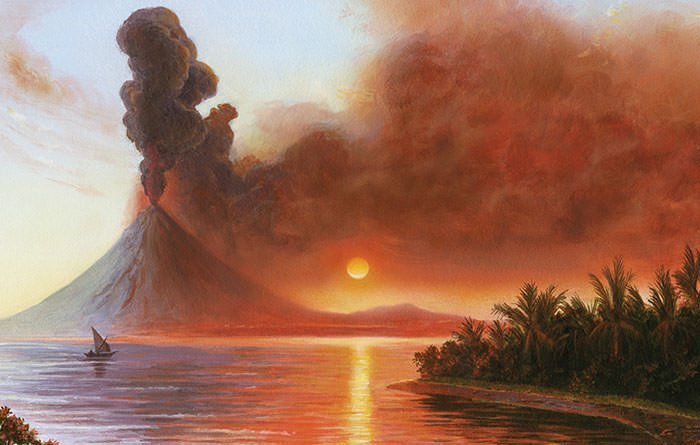innovuscollege.com – In April 1815, the eruption of Mount Tambora on the island of Sumbawa in Indonesia became one of the most powerful volcanic events in recorded history. This catastrophic explosion not only devastated the local environment but also had far-reaching effects on global climate, agriculture, and human society, marking it as one of the most significant yet little-known events of the 19th century.
The Eruption: A Cataclysmic Force
Mount Tambora, a stratovolcano, had been dormant for centuries before its fateful eruption. On April 10, 1815, after days of rumbling and smaller explosions, Tambora erupted with an intensity that was unprecedented. The eruption spewed an estimated 160 cubic kilometers of volcanic material into the atmosphere, obliterating the top of the mountain and reducing its height by about 1,300 meters.
The explosion was so powerful that it was heard up to 2,000 kilometers away, and ash clouds darkened the skies across the region. The immediate impact was devastating: pyroclastic flows and ashfall wiped out entire villages, killing an estimated 71,000 people—a combination of direct fatalities and subsequent famine and disease outbreaks.
The “Year Without a Summer”
The eruption’s global consequences were profound. Massive amounts of sulfur dioxide were injected into the stratosphere, forming a sulfuric acid aerosol veil that encircled the Earth. This veil reflected sunlight back into space, causing a phenomenon known as volcanic winter.
In 1816, the world experienced what came to be known as the “Year Without a Summer.” Temperatures plummeted by as much as 3°C in the Northern Hemisphere, leading to crop failures and food shortages. Snow fell in June in parts of North America, and Europe endured unseasonable frost and relentless rain.
The agricultural collapse resulted in widespread famine. In Switzerland, for example, food prices soared, and desperate populations resorted to eating grass and bark. In New England, farmers migrated westward in search of more hospitable conditions. Across Asia, disrupted monsoons led to flooding and famine, particularly in India and China.
Cultural and Scientific Impact
The global upheaval caused by Tambora’s eruption left an indelible mark on culture and science. The gloomy, ash-laden skies over Europe inspired some of the era’s most notable works of art and literature. Mary Shelley, staying in a rain-drenched villa in Switzerland, conceived the story of Frankenstein amid the eerie, volcanic twilight. Similarly, J.M.W. Turner’s dramatic landscape paintings are thought to reflect the striking sunsets caused by volcanic aerosols.
Scientifically, Tambora’s eruption spurred advancements in the study of meteorology and volcanology. It was one of the first events to reveal the interconnectedness of the Earth’s climate systems, highlighting how distant events could have cascading global effects.
Lessons for the Modern World
Mount Tambora’s eruption serves as a powerful reminder of the fragility of human societies in the face of natural disasters. Modern volcanic eruptions, though often less catastrophic, still disrupt air travel, agriculture, and local populations. The Tambora event underscores the importance of monitoring volcanic activity and preparing for its potential impacts.
Additionally, the “Year Without a Summer” is a historical example of how abrupt climate changes can have devastating societal consequences. As the world grapples with anthropogenic climate change, Tambora’s legacy offers a cautionary tale about the far-reaching effects of atmospheric disruptions.
Conclusion
The eruption of Mount Tambora in 1815 was more than a natural disaster; it was a transformative global event that reshaped societies, altered climates, and inspired cultural masterpieces. Though often overshadowed by other historical milestones, its legacy endures as a testament to nature’s immense power and the resilience of human communities in the face of adversity.





